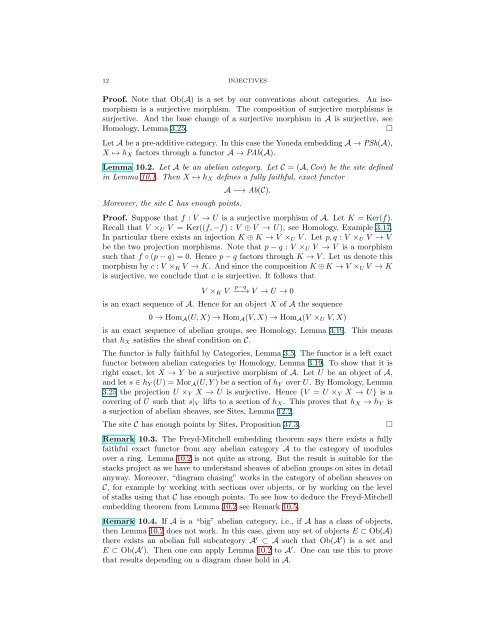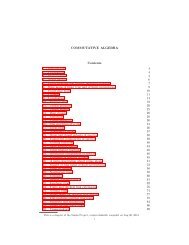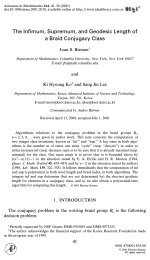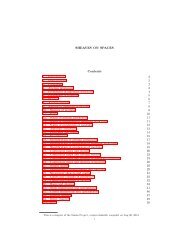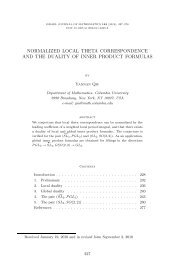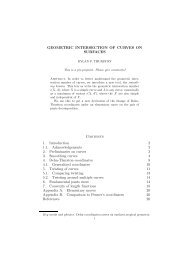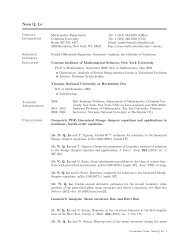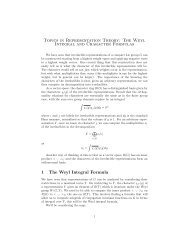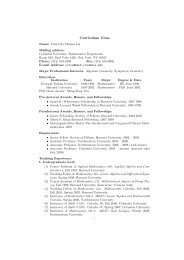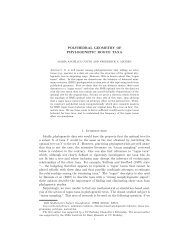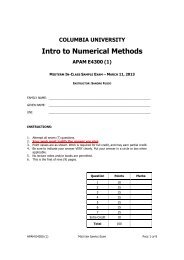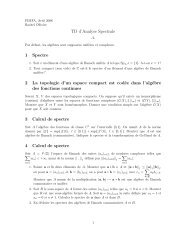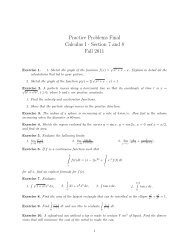INJECTIVES Contents 1. Introduction 1 2. Modules ... - Stacks Project
INJECTIVES Contents 1. Introduction 1 2. Modules ... - Stacks Project
INJECTIVES Contents 1. Introduction 1 2. Modules ... - Stacks Project
Create successful ePaper yourself
Turn your PDF publications into a flip-book with our unique Google optimized e-Paper software.
12 <strong>INJECTIVES</strong><br />
Proof. Note that Ob(A) is a set by our conventions about categories. An isomorphism<br />
is a surjective morphism. The composition of surjective morphisms is<br />
surjective. And the base change of a surjective morphism in A is surjective, see<br />
Homology, Lemma 3.25. <br />
Let A be a pre-additive category. In this case the Yoneda embedding A → PSh(A),<br />
X ↦→ hX factors through a functor A → PAb(A).<br />
Lemma 10.<strong>2.</strong> Let A be an abelian category. Let C = (A, Cov) be the site defined<br />
in Lemma 10.<strong>1.</strong> Then X ↦→ hX defines a fully faithful, exact functor<br />
Moreover, the site C has enough points.<br />
A −→ Ab(C).<br />
Proof. Suppose that f : V → U is a surjective morphism of A. Let K = Ker(f).<br />
Recall that V ×U V = Ker((f, −f) : V ⊕ V → U), see Homology, Example 3.17.<br />
In particular there exists an injection K ⊕ K → V ×U V . Let p, q : V ×U V → V<br />
be the two projection morphisms. Note that p − q : V ×U V → V is a morphism<br />
such that f ◦ (p − q) = 0. Hence p − q factors through K → V . Let us denote this<br />
morphism by c : V ×K V → K. And since the composition K ⊕ K → V ×U V → K<br />
is surjective, we conclude that c is surjective. It follows that<br />
V ×K V p−q<br />
−−→ V → U → 0<br />
is an exact sequence of A. Hence for an object X of A the sequence<br />
0 → HomA(U, X) → HomA(V, X) → HomA(V ×U V, X)<br />
is an exact sequence of abelian groups, see Homology, Lemma 3.19. This means<br />
that hX satisfies the sheaf condition on C.<br />
The functor is fully faithful by Categories, Lemma 3.5. The functor is a left exact<br />
functor between abelian categories by Homology, Lemma 3.19. To show that it is<br />
right exact, let X → Y be a surjective morphism of A. Let U be an object of A,<br />
and let s ∈ hY (U) = MorA(U, Y ) be a section of hY over U. By Homology, Lemma<br />
3.25 the projection U ×Y X → U is surjective. Hence {V = U ×Y X → U} is a<br />
covering of U such that s|V lifts to a section of hX. This proves that hX → hY is<br />
a surjection of abelian sheaves, see Sites, Lemma 1<strong>2.</strong><strong>2.</strong><br />
The site C has enough points by Sites, Proposition 37.3. <br />
Remark 10.3. The Freyd-Mitchell embedding theorem says there exists a fully<br />
faithful exact functor from any abelian category A to the category of modules<br />
over a ring. Lemma 10.2 is not quite as strong. But the result is suitable for the<br />
stacks project as we have to understand sheaves of abelian groups on sites in detail<br />
anyway. Moreover, “diagram chasing” works in the category of abelian sheaves on<br />
C, for example by working with sections over objects, or by working on the level<br />
of stalks using that C has enough points. To see how to deduce the Freyd-Mitchell<br />
embedding theorem from Lemma 10.2 see Remark 10.5.<br />
Remark 10.4. If A is a “big” abelian category, i.e., if A has a class of objects,<br />
then Lemma 10.2 does not work. In this case, given any set of objects E ⊂ Ob(A)<br />
there exists an abelian full subcategory A ′ ⊂ A such that Ob(A ′ ) is a set and<br />
E ⊂ Ob(A ′ ). Then one can apply Lemma 10.2 to A ′ . One can use this to prove<br />
that results depending on a diagram chase hold in A.


